
Donald Trump online
How Trump used social media in his campaign
In the following paper we will explain how the political figure Donald Trump uses social media and its format for his benefit.
A big part of people’s lives in the 21st century is spent online, and even more specifically, on social media. Different platforms with their particular features, serve different needs. Some of these features are better suited than others to realize certain political goals or to emphasize certain issues. This became clear during the political campaigns of both Clinton and Trump. Both of the candidates have social media accounts, which became an important battle ground in the presidential campaign. In this article, we analyze how Donald Trump used his Twitter and Facebook accounts. We concentrated on the day of the third presendential debate, October 20, 2016. We invesitgated, collected data from, and analyzed the two accounts.
New media, format and message
Each medium has its own characteristics. Radio and television were once called the ''new media''. Nowadays new media are considered internet-based. These media are active and visible 24/7. As a result, the management of visibilltiy has also become an around-the-clock enterprise. In the new world of mediated visibility, making action visible is a an important instrument to construct one's message in political campaigns (Thompson, 2005). It is important to emphasize the fact that the word message here does not mean just 'content', but also how a politician discusses issues, especially during certain campaigns (Lempert & Silverstein, 2012). Style and image are an integral part of one's message.
According to Thompson (2005), because of the decline of old ideological politics, people feel uncertain how to tackle the massive and complex problem of the modern world. In this context, the character of the individual who is —or is going to become— the leader is more important, as well as his or her trustworthiness. The focus on scandal in politics is a kind of measure of a politician's candor. How politicians act in their social lives says something about their integrity. Because of that, according to Blommaert (2005), we need to investigate how the message is organized, mediated, and reconstructed by the ideological actors using it.
The study of message and ideology necessarily looks at media. It is the media who have the power to construct deep ideological messages out of insignificant events and phenomena (Blommaert, 2005). It is therefore important to analyze the media field and how it is structured. The new media formats are corporate based and their goal is profit. Every way of containing information and organising this information creates a certain data architecture of its own that has cultural implications. With data-based platforms, the way of organizing and who does it, has changed. Within the internet, the concept of rhizome exists; there is a constant production of discourse and counter-discourse. Even though the rhizome is a nonhierarchical system, which constantly transforms and modifies both itself and what it encounters, in the case of new media, we see that certain corporations control the rhizome more than others. Because of these constant modifications, it is hard to trace back to the center of origin and the management of meaning.
Social media and Trump's message
On October 20, 2016, the third presidential debate took place in Las Vegas, Nevada. On the night of the debate, Donald Trump not only had to manage his television performance, he also had to manage his online visibility on Twitter, Facebook, and Instagram. It is crucial to mention that on the specific date of the debate, both politicians and their team became even more active on social media. For instance, during and after the debate, we counted 32 different posts on Donald Trump's Facebook account, all related to what he was saying in real-time on television.
Were Trump's Tweets even real?
With new media such as Twitter, politicians need to consider how to use the format to gain profit, target their audience, and convince voters that he or she is the 'right candidate' for them. Donald Trump has considerably (millions) more followers on his social media account such as Twitter, Facebook and Instagram than his opponent Hillary Clinton.
Trump, with his parler vrai, constructs an aura of 'realness' around his discourse. His dares to be politically incorrect, which produces the idea that he is 'really' himself. He is seemingly sincere in his speech and message. He brashly says what he thinks, even if this creates commotion. One by-product of this parler vrai is that his Tweets are scrutinized and get mass-media attention. Management of visibility, in the context of Trump, means 'creating good controversy'; controversy that sustains his image of being 'anti-establishment' (Maly, 2016). On the night of the third debate, he handed over his Twitter account to his 'team of deplorables'. He managed to be visible not only on the television, but also on Twitter. Before we analyze the social-media-posting further, two points deserve our attention:
(1) by communicating that he 'will be handing over' his account, he also communicates that he is normally the one doing the tweeting, not his campaign team.
(2) By reapproriating Clinton's 'depolorables' discourse, Trump underlines his general message: 'I'm sticking up for the common man. I'm happy to be the voice of what the establishment calls deplorable.'
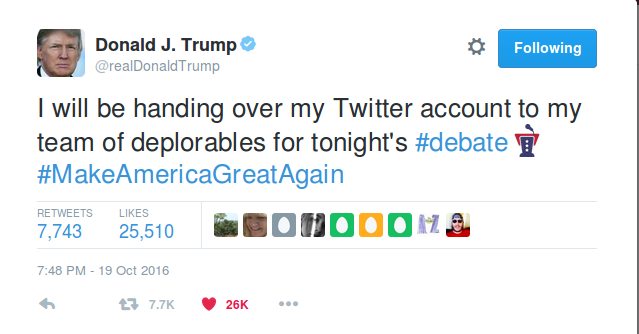
Donald Trump's post on Twitter before the third debate
During the debate, there were 67 tweets posted on Twitter, ceasing only when Trump made clear that he was done with the debate and was glad that he could make all his points. That tweet, with 23k retweets and 73k saved as a favorite by his followers, was the most popular tweet of the day.
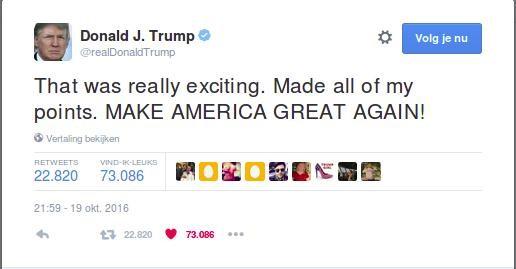
The social media communication was clearly planned. There were a limited number of hashtags, used to make them viral. With his team on Twitter, responding live on the debate using hashtags #debate, #MAGA (Make America Great Again) and #BigLeagueTruth, there is a fast, short, and instant communication controlled by Trump's team.
Drain the swamp was a new hashtag created for the final debate, referring to the fact that the Obama administration with Hillary Clinton as secretary of state made a mess of the United States, and that Trump is there to clean up this swamp. This is similar to the Big league truth hashtag; it connects with Clinton about the fact that she is a liar and that Trump is here to reveal the truth.
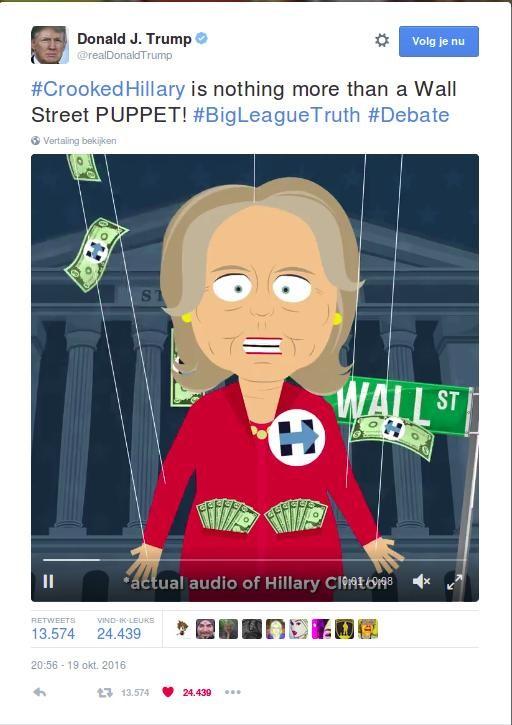
Hashtag usage and spreading the message.
The message Trump's campaign is distributing is very consistent: he is the one that will clean up the mess. A political cartoon circulated in the days before the debate, that summarized Trump's message well. Trump is depicted as the one cleaning the swamp, and the swamp represents everything that is wrong with America according to him: Crooked Hillary, the failing (liberal) media, Soros, but also Republicans who do not support him. By using the above mentioned hashtags and hashtags such as #CrookedHillary and #DrainTheSwamp, there is an interaction with a big group of people. The people who are reacting and reproducing these tweets are mostly Trump supporters; the Hillary Clinton supporters do not bother to react on these accusations about Hillary Clinton. In fact, there is very little criticism on the tweets. All those slogans interact and target Clinton, but Clinton and her supporters seemingly don't engage in a discursive online war on Trump's terrain. This creates the idea that his message only gets support. The idea is further underlined by Trump, who after the debate posted some tweets with online polls where he was the winner of the final presidential debate.
Trump's Facebook
His Facebook account, just like his Twitter account, was handed to his team. This team must have consisted of a significant amount of people in order to manage all the posts and videos which were going online. The presidential campaign battles grew massively and took over the field of social media. One example demonstrating this is the hashtag usage. This action is not as popular on Facebook as it is on Instagram and Twitter, but Trump and his team use the symbol on this social media as well in order to link his posts to the other social media. In the night of third debate, as mentioned above, many of Trump's posts on Facebook include the hashtag #DrainTheSwamp as well as on his Twitter account.
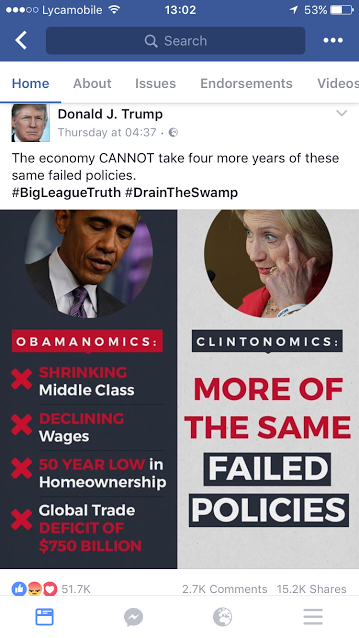
Trump Facebook post 29 Oktober 2016
Facebook is probably one of the most popular social platforms, which replaced MySpace years ago and became one of the most used media (boyd, 2014: 27). No matter that some people predict the death of Facebook, it was very important in this political campaign. On Facebook users can do more than liking; with the new innovation, people can show their feelings of love, laughing, amazement, sadness and anger. One of the latest features on Facebook is the option to post Facebook-Live Videos. Politicians and their crew take all possible advantages of this innovation online. Trump especially used Facebook-Live Videos. Right after the third debate, he started a new live video which was viewed by nine million people.
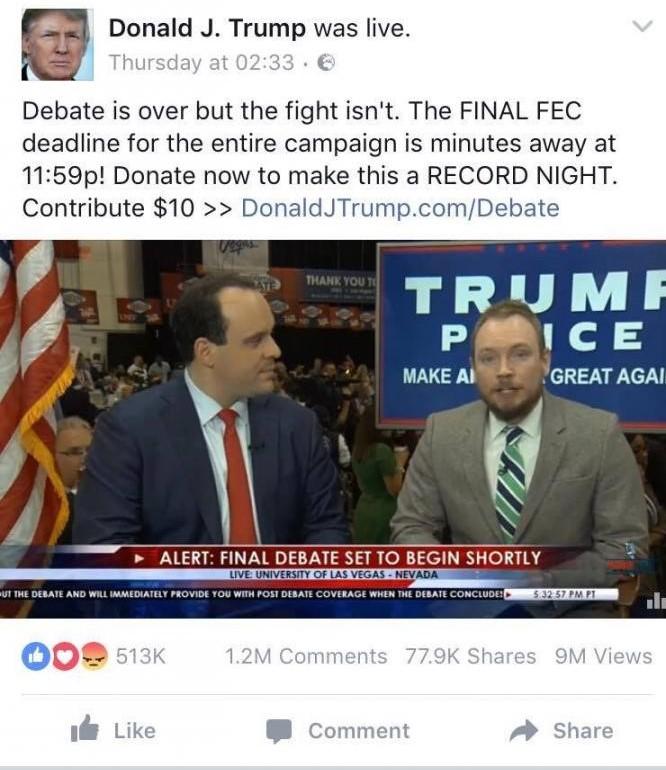
The amount of comments and people who shared the video is also gigantic: 1.2 million comments and 77.9 thousands of share posts. This, along with the number of views, shows and proves the massiveness of social media. Immediately after the debate, people stayed tuned and showed their reaction in the easiest way possible–by clicking.
Additionally, when a friend or a Facebook page you follow goes 'live' on Facebook, the user receives a notification. Facebook promoted this new feature, and Trump took advantage of it. If you followed him and were online, it was hard to miss it. It shows how the algorithmical nature of these platforms can become a political fact. If a user likes a page and shows interest in the page by liking, sharing and writing comments, the platform starts including the page’s post on the news feed. Also, Facebook starts suggesting similar pages that could be liked and followed: it creates a filterbubble. The essential concept of media is, that it mediates between us and the world as we perceive it. Media is a fundamental part of our lives and how we look at the world. Algorithms process the data and present data that is relevant for you. Because of these algorithms you will only see what you want to see and fits in your world view and ideology. The algorithm of social media filters everything according to users' possible interests, so they start living in a so called filter bubble (Sunstein 2002, 2006; Pariser 2011b). This personalization of users' news feed creates a risk of missing information and seeing different points of view, because it is based only on individual needs (Bozdag,2013).
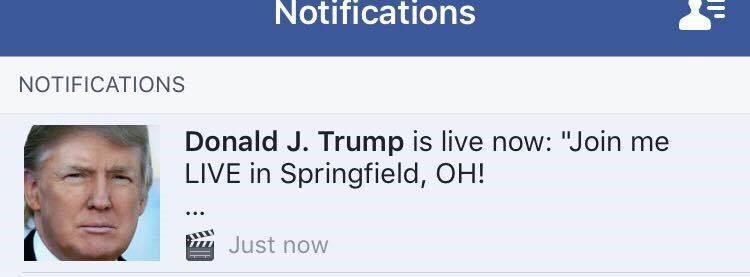
In comparison to the massive live video right after the debate, the next live video on Trump’s Facebook account is from Ohio. On Facebook, there is an option to create an 'event' to let all of your followers know where and when you are going to be. This makes the event even bigger, because all the followers from Ohio would know for it. As might be expected, Trump again went out this night with a message JOIN ME LIVE IN OHIO! He made it personal, and his video's look amateuristic, and one might say even more 'real'. Of course it is obvious that the video is recorded by somebody else. The numbers under the post are not as high as the video mentioned above, but it should not be underestimated. 173 thousand reactions, including like, love and angry; 147 thousand comments; 25 thousand shares; and the most significant number is that of viewers–over one million.
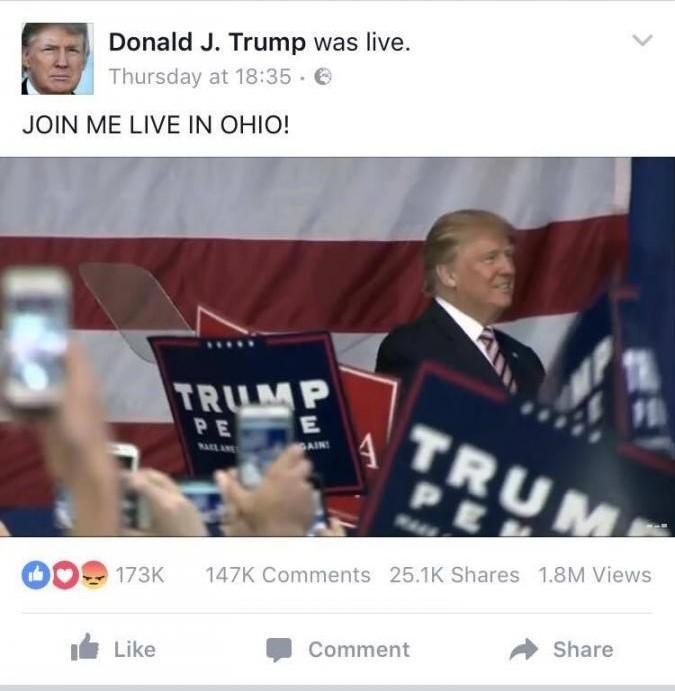
The power of simplicity
Trump has kept it simple. His simple, controversial, and consistent message was communicatied through different media. Simple solutions for the complex problems of the modern world fit the formats of commercial mass media and are picked up by the algorithms of social media. His 'parler vrai' wrapped in one-liners communicated a sincere and true character.
The scandals in his private life were all made public. To a normal, middle-of-the-road politician, this should have been the end. But in Trump's case, it added to his message of being who he is: a man of the people, who sometimes says the wrong things, but who means well. All publicity is good publicity. Beside that, when he was attacked on his female-unfriendly or bad behavior, he used counter arguments about Hillary Clinton and her husband to emphasize that Bill Clinton's actions were worse. In this way, Trump continues to stress that 'they are biased' against him, and that he is more trustworthy.
Donald Trump knows very well that mediated visibility can be used as an instrument and a weapon to wage his politics. So instead of trying to control this mediated visibility, he uses it as his strategy.
References
Blommaert, J. (2005). Ideology. Discourse. A Critical Introduction. New York: Cambridge University Press, 158-202
boyd, d. (2014). It's complicated. The social lives of networked teens. New Haven & London: Yale University Press.
Bozdag, E. Ethics Inf Technol (2013) 15: 209. doi:10.1007/s10676-013-9321-6
Lempert, M. and Silverstein, M. (2012). Creatures of politics. Media, message and the American presidency. Bloomington and Indianapolis: Indiana University Press.
Maly, I. (2016). Trump, the celebrity-businessman and vox populism. explaining trump's message-part 2. Diggit Magazine. Retrieved from: https://www.diggitmagazine.com on November 11, 2016.
Thompson, J, B. (2005). The new visibility. Theory, culture & society. 22 (6), 31-51. doi: 10.1177/0263276405059413